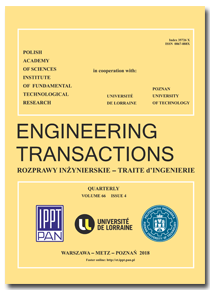10.24423/engtrans.137.2011
Development of a Numerical Model of the 9 mm Parabellum FMJ Bullet Including Jacket Failure
References
F. Bresson, O. Franck, Estimating the shooting distance of a 9 mm Parabellum bullet via ballistic experiment, Forensic Science International, 192, 1–3, 17–20, 2009.
K. G. Sellier, B. P. Kneubuehl, Wound ballistic and the scientific background, Elsevier 1994.
F. Bresson, O. Franck, Comparing ballistic wounds with experiments on body simulator, Forensic Science International, 198, 1–3, 23–27, 2010.
G. R. Johnson, W. H. Cook, A constitutive model and data for metals subjected to large strains, high strain rates and high temperatures, Proceedings of seventh international symposium on ballistics, The Hague, the Netherlands, 1983.
G. Gary, V. Degreef, David, Labview Version, Users manual version, LMS Polytechnique, Palaiseau, 2008.
K. Safa, G. Gary, Displacement correction for punching at a dynamically loaded bar end, International Journal of Impact Engineering, 37, 4, 371–384, 2010.
S. Chocron, C. E. Andersen Jr, D. J. Grosch, C. H. Popelar, Impact of the 7.62 mm APM2 projectile against the edge of a metallic target, International Journal of Impact Engineering, 25, 23–37, 2001.
C. E. Andersen Jr, M. S. Burkins, J. D. Walker, W. A. Gooch, Time-resolved penetration of B4C tiles by the APM2 bullet, Computer Modeling in Engineering & Sciences, 8, 2, 91–104, 2005.
M. G. Cockroft, D. J. Latham, Ductility and the workability of metals, Journal of the Institute of Metals, 96, 33–39, 1968.
T. Børvik, S. Dey, A. H. Clausen, Perforation resistance of five different high-strength steel plates subjected to small-arms projectiles, International Journal of Impact Engineering, 36, 7, 948–964, 2009.
DOI: 10.24423/engtrans.137.2011




